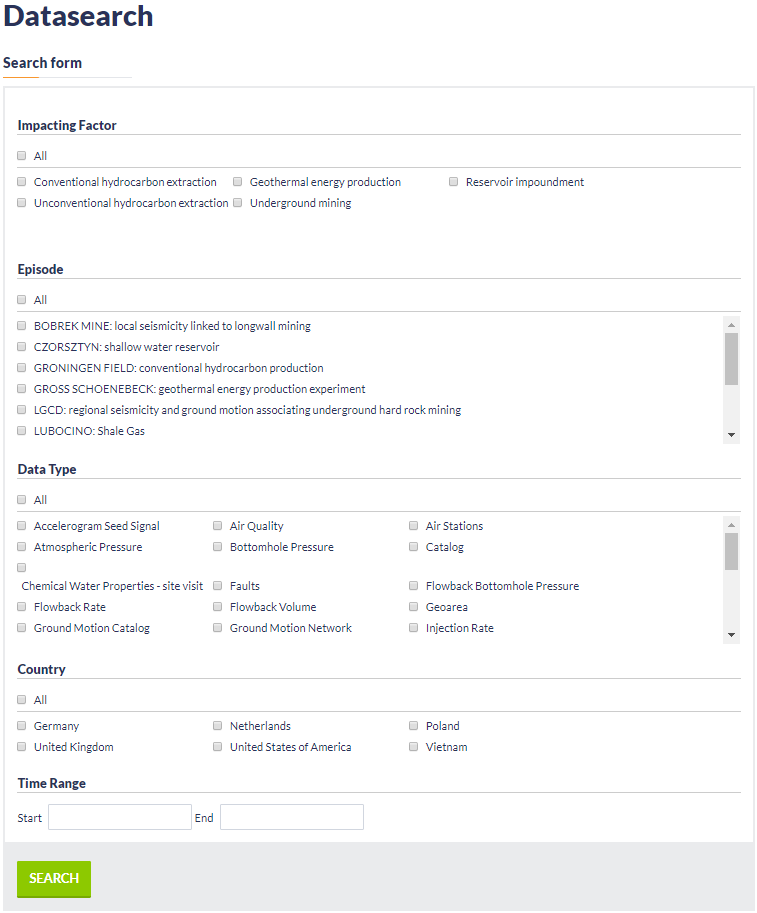Page History
In the present platform version the available services Applications ("ServicesApplications" tag in the IS-EPOS main page) are grouped into the categories shown in Figure 1, each one containing several applications (click on each category to extend the servicesApplications for details):
Figure 1.
- Low level-services (Figure 2) comprise the following applications (See "Low Level Services" chapter for a detailed description):
...
Figure 2.
- High level services contain advanced methodologies for Anthropogenic Seismicity data analysis grouped as indicated in Figure 3. Note that each one of the High Level Services are described in detail in special chapters.
...
Figure 3.
Each one of these categories contain a number of applications that the user can utilize for episode data analysisIn general, Applications in IS-EPOS can be divided into Data Handling and Data Processing Applications in terms of their outputs. Data Processing Applications sustain advanced methodologies for AH data analysis, whereas Data Handling Applications comprise tools for data transformation and handling. A possible taxonomy of the Data Processing Application is the following. These applications are available after clicking on one of the categories and then on "add to workspace" panel (right side of Figure 4) and comprise in detail:1).
- Collective properties of seismicity:
- Seismic Activity - Inter-event Time Distribution Analysis
- Source Size Distribution
- Completeness Magnitude Estimation
- Source Size Distribution Functions (Also found in the next category)
- Probabilistic Seismic Hazard Analysis - stationary
- Hazard Parameters Estimation
- Exceedance Probability
- Maximum Credible Magnitude
- Mean Return Period
- Source Effect
- Source Size Distribution Functions (Also found in the previous category)
- Hazard Parameters Estimation
- Probabilistic Seismic Hazard Analysis - time dependent
- Time Dependent Seismic Hazard Parameters
- Stationary inducing factor
- Time Dependent Seismic Hazard Parameters for Stationary Geometry
- Time Varying inducing factor
- Time Dependent Seismic Hazard Parameters for Time Varying Geometry
- Source Parameter Estimation
- Earthquake Spectra
- Spectral Analysis
- Source Location
- Localization (TRMLOC)
- Moment Tensor Inversion
- Moment Tensor Inversion (FOCI)
- Earthquake Spectra
- Stress Field Modeling
- Stress Inversion from Focal Mechanisms
...
- Fracture Network Models - Mechanical Stresses
- Technology - Seismicity Interaction
- Correlation Analysis
- Autocorrelation
- Coefficient of Randomness
- Cross Correlation
- Priestley-Subba Rao Test
- Correlation Analysis
Alternatively the user may browse an Episode, upload the data he/she wishes to use for analysis to the personal workspace, and then use these data for visualization, high level application or low level (Simple Component) application (see figures below).
Step 1:Browse Anthropogenic Hazard Episodes by clicking on "AH Episodes" tag in the top left corner of the main menu (tag into the red frame in Figure 5):
Figure 5.
Step 2: Select and select a specific Episode from the list by clicking on one of the panels (e.g. the one indicated by the red box in Figure 62):
Figure 62.
Step 32: Select a data type from the list (e.g. catalog in the example shown in Figure 73). There are several data types available with respect to the episode and the induced seismicity technology:
Figure 73.
Step 43: Once the User selects one data type he obtains access to data attributes, numerical values and visualization servicesapplications. For further data processing the User has to click on the "Actions" tab and then on the "ADD TO WORKSPACE" window which appear right below (red frame at the top of Figure 84):
Figure 84.
Alternatively, the User may continue from step 2, through the following process:
Step 3b: After selecting an episode the user may receive access to all available data from any episode by clicking onthe on the "All data related to this episode" tab (red box, in the bottom left corner of Figure 95).
Figure 95.
Step 4b3b: A Data search screen is now displayed (See also "Advanced Data Search" in "AH Episodes" chapter). The User may either select one or more (even all) episodes, or apply a filter from the list provided such as time range, country, data type etc (Figure 106).
Figure 106.
Step 5b3c: All data after the filtering criteria application is now demonstrated and the User may select one or more data types for further processing. If the User chooses the "View File" tab, the same screen as in Step 4the previous step, appears. If the User clicks at the "Add to Workspace" tab, the data is directly transferred to his/hers personal workspace (Figure 117). (See also AH Episodes chapter)
Figure 117.
Once the selected data is uploaded at the personal workspace, the User may click on the "Actions" tab in order to use these data in one of the available servicesapplications, grouped into 3 categories: "USE IN APPLICATION", "USE IN VISUALIZATION", "USE IN SIMPLE COMPONENT". This is the Data Oriented Approach shown in Figure 128.
Figure 128.
Alternatively, a Service an Application Oriented Approach can be followed as displayed in Figure 139. The User selects the service Application first and then clicks on the "Change input" tab for choosing (Shown in the red frame of Figure 139) the appropriate input data file(s).
Figure 139.









